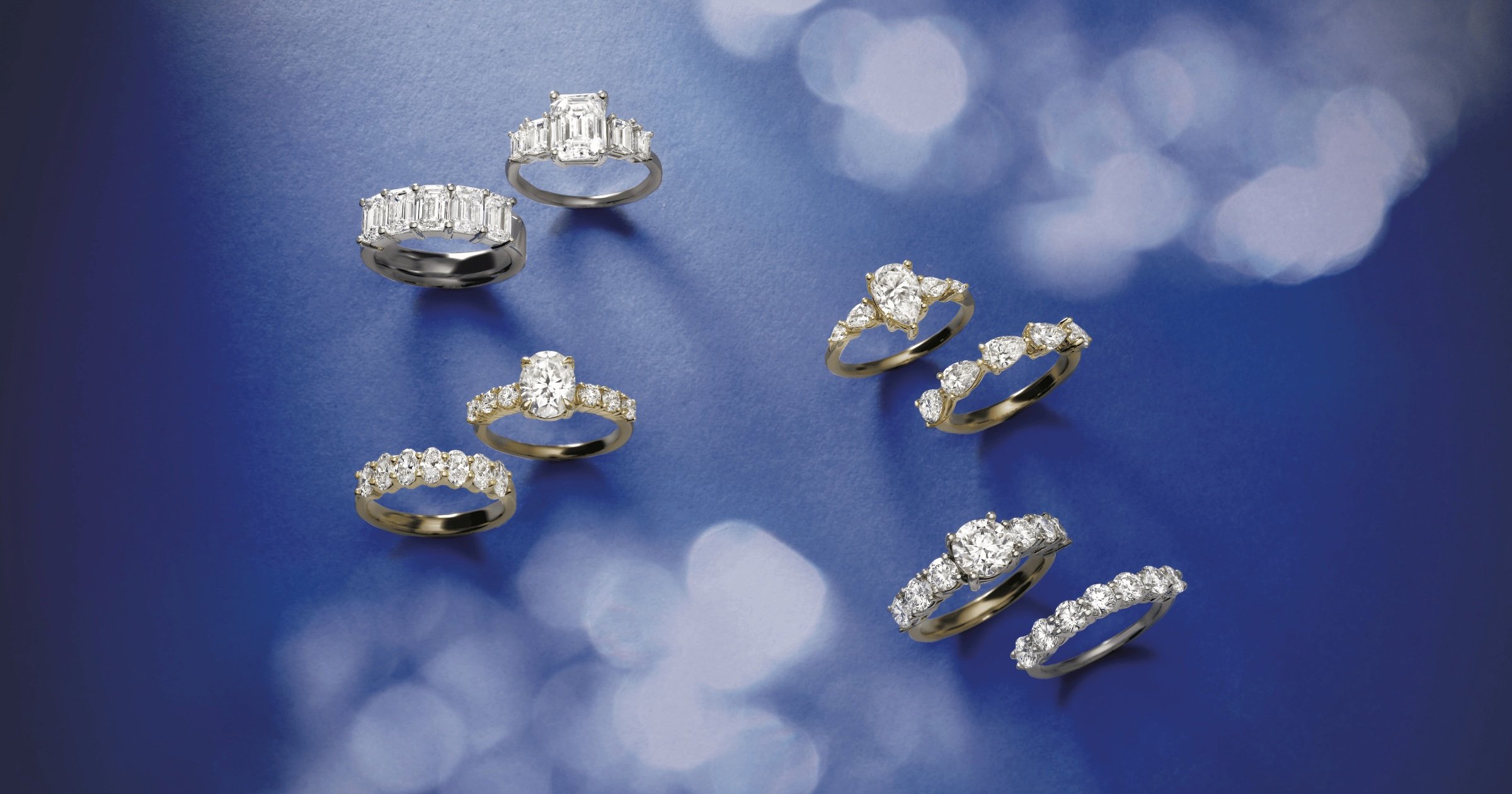Guide to Common Engagement Ring Repairs & Common Wear and Tear
Your engagement ring is built to last, but just like anything you wear daily, it’s bound to show signs of use over time. Whether it’s a minor scratch, a slightly loose stone, or a bent band, these issues are completely normal. The good news? Most common engagement ring repairs are straightforward and regular maintenance along with proper care can keep your ring looking as good as new.
In this guide, we’ll break down what kind of wear and tear you can expect, the most common repairs, and how to keep your ring in top shape for years to come.
Key Takeaways
- Wear and Tear Is Normal, But Maintenance Matters: Daily activities can naturally cause engagement rings to show signs of wear over time, including scratches, bent bands, and loose stones. This doesn’t mean your ring is poorly made—it just means it's being worn and loved. Regular maintenance helps prevent bigger issues.
- Common Repairs Are Simple and Effective: Most engagement ring issues, like prong repairs, stone replacements, and reshaping bent bands, are straightforward fixes when handled by a professional jeweler. Addressing these problems early can extend the life of your ring.
- Preventative Care Saves You Time and Money: Being mindful of when and how you wear your ring and routine professional inspections can minimize the need for repair and keep your ring in top condition. Simple habits like taking it off during heavy activities and regular cleanings can make a big difference.

Why Engagement Ring Wear and Tear Is Normal
Just like a favorite watch or a well-worn pair of shoes, your engagement ring will naturally show signs of daily wear. That doesn’t mean there’s anything wrong with it—it just means it's doing its job. Just like cars and musical instruments, fine jewelry requires regular service and maintenance to keep your ring in tip-top shape.
Let’s take a closer look at the common ways rings experience wear and tear and what that means for long-term care.
Understanding Daily Wear and Tear
Think about how often you use your hands—typing, lifting, cooking, working out. Your ring is along for the ride through all of it. Over time, these daily activities cause natural wear, from small scratches to metal thinning. This doesn’t mean your ring is low quality—it just means it’s being loved and lived in.
Your ring also interacts with various materials throughout the day. Hard surfaces like countertops, door handles, and gym equipment can put stress on the metal and prongs. Lotions, soaps, and even natural oils from your skin can cause buildup and dull the ring’s sparkle. Understanding these factors helps you recognize why maintenance is necessary.
Rings Are Meant To Be Worn
An engagement ring isn’t meant to sit in a box. It’s a symbol of commitment meant to be part of your everyday life. While it’s good to be mindful of when and how you wear it, the goal isn’t to keep it pristine forever—it’s to wear it with pride. Knowing that wear and tear is expected makes it easier to take the right steps to maintain it over time.
That said, some activities can put excessive strain on your ring. If you work with your hands a lot—whether in construction, healthcare, or fitness—you might want to take extra precautions or consider a temporary alternative ring for those activities.
_Accented_Engagement_Ring_and_Matching_Wedding_Band_shown_with_Complementing_Mens_Wedding_Band_in_navy_blue_ring_box_with_ribbon.jpeg?width=900&height=473&name=White_Gold_(or_Platinum)_Accented_Engagement_Ring_and_Matching_Wedding_Band_shown_with_Complementing_Mens_Wedding_Band_in_navy_blue_ring_box_with_ribbon.jpeg)
Common Engagement Ring Repairs Explained
Even with the best care, engagement rings sometimes need repairs. Here are the most common fixes jewelers handle and what they involve:

Stone Replacement
A loose or missing stone can happen if the prongs holding it wear down over time. If you notice a stone moving when you touch it or hear a slight rattle, it’s time to get it checked. A jeweler can tighten or replace the stone to ensure it stays secure. If you aren’t sure about the security of your prongs, stop by our office or ship it to us and we’ll have our jewelers do a full inspection of your ring to make sure the prongs are holding your stone perfectly in tact.
Diamonds and gemstones can also chip or crack if hit at the right angle. While diamonds are one of the hardest materials, they aren’t indestructible. If a stone gets damaged, a jeweler can help find a replacement that matches the original in size and quality.

Shank Misshaping or Deformation
The shank (the band of your ring) can bend out of shape from activities like accidentally hitting it on something, gripping weights at the gym, or carrying heavy bags. Softer metals like gold are particularly prone to bending over time. If your ring no longer sits evenly on your finger, a jeweler can reshape it without weakening the metal.
In some cases, a reshaped shank may indicate a deeper issue, such as a thinning band. If this happens, jewelers can reinforce the shank with additional metal to restore its durability.

Scratches and Dents on the Shank
Gold and platinum are durable, but they’re not scratch-proof. Over time, your ring may pick up small marks from everyday wear. A professional jeweler can polish and smooth out minor scratches, while deeper dents might require more intensive refinishing.
Brushed or matte-finish rings may also wear down over time, developing a shinier look due to friction. If you prefer a specific finish, a jeweler can restore it to its original texture.

Prong Repairs
Prongs play a crucial role in securing your stone, but they can wear down or even break over time. If a prong gets too thin, it won’t hold the stone as tightly as it should. A jeweler can rebuild or replace prongs to ensure your diamond or gemstone stays in place.
Regular prong checks are crucial, as a broken or weak prong can lead to losing your stone. Most jewelers recommend having your prongs inspected at least once a year.
Preventative Care to Minimize Wear and Tear
While some wear and tear is unavoidable, there are ways to keep your ring in great shape longer:
- Take it off when doing heavy lifting, exercising, or using harsh chemicals like cleaners.
- Store it in a soft pouch or jewelry box when not wearing it.
- Get it professionally cleaned and inspected at least once a year.
- Avoid wearing it in swimming pools or hot tubs, as chlorine can weaken metal over time.
- Be mindful of your ring’s setting and metal type—some are more durable than others.
Regular professional maintenance can catch minor issues before they become costly repairs. Jewelers can check for loose stones, worn prongs, and other signs of wear to help extend your ring’s lifespan.
In addition to regular care, ensuring your ring is insured is one of the best ways to protect your investment. While all policies will vary, insurance can cover repairs, replacements, or even loss, giving you peace of mind no matter what happens. Many jewelers offer insurance recommendations, or you can add your ring to an existing policy for extra protection.
_and_Yellow_Gold_Solitaire_Engagement_Rings_shown_with_Complementary_Countoured_Wedding_Bands.png?width=900&height=473&name=White_Gold_(or_Platinum)_and_Yellow_Gold_Solitaire_Engagement_Rings_shown_with_Complementary_Countoured_Wedding_Bands.png)
When to Have a Professional Help
If you notice your ring looking worn, a prong catching on fabric, or a stone sitting unevenly, don’t wait—take it to a professional jeweler (or if you’re an FP client, send it in to us through the repair form in your client portal). Routine inspections can catch small issues before they turn into bigger problems, saving you from costly repairs down the road.
Why Engagement Ring Repairs Are Normal (and Ensure It Lasts Long)
Engagement rings are meant to last a lifetime, but they require care and occasional repairs to stay in top condition. Just like maintaining a car or a favorite piece of clothing, routine upkeep ensures your ring remains secure and beautiful. Regular inspections and timely repairs help prevent minor wear from turning into major damage, keeping your ring a cherished piece for years to come.
Need a Ring Repair or Consultation? See How Faithful Platform Can Help You
At Faithful Platform, we believe in making fine jewelry that lasts and reflects your unique style, story, and budget. If your ring needs a repair, or a simple inspection and a professional cleaning, we’re here to help. Our experts can assess your ring and make sure it stays as stunning as the day you first put it on.
Reach out to us today for a consultation or repair service!

Frequently Asked Questions (FAQs)
Is it common for engagement rings to break?
Yes, but not in the way you might think. Rings rarely snap in half without reason, but prongs can weaken, bands can bend, and stones can become loose over time. Regular maintenance helps prevent serious damage.
Why is my ring’s shank misshapen?
The shank can bend due to constant pressure from gripping, lifting, or accidental knocks. Softer metals like gold are more prone to misshaping over time due to daily wear and tear.
What causes scratches or dents on my ring?
Daily activities, contact with hard surfaces, and even friction from everyday wear can lead to scratches and dents. Professional polishing can remove minor marks, while deeper dents may require a more thorough refinishing.
Can you repair an engagement ring?
Yes, though sometimes depending on the extent of the damage, recasting a ring may be necessary and require a more expensive fix. Jewelers can repair most types of damage, including prong issues, loose stones, reshaping, and refinishing. Regular checkups can catch small problems before they get worse.
Can a broken engagement ring be fixed?
Yes, depending on the damage. Bent bands, missing stones, and worn prongs are all repairable. If the ring is severely damaged, jewelers can often restore it with recasting or expert craftsmanship.
How much does it cost to repair a ring?
Repair costs vary based on the issue. Simple prong repairs might cost $50-$100, while stone replacements or reshaping can range from $100-$500, depending on materials and labor. FP clients can rest assured knowing we won't charge you more than what it costs us to make the repair, but this may not be the case for all jewelers.
How much does it cost to get a diamond set back in a ring?
Resetting a diamond usually costs between $50 and $300, depending on the setting type and any additional work required, like prong repairs or securing the stone.
How long does it take a jeweler to fix a ring?
It depends on the repair, but most standard fixes take anywhere from a few days to two weeks. More complex repairs, like resizing or resetting multiple stones, may take longer. Faithful Platform quotes a two-week (or ten business days) turnaround time for common repairs and resizes.
